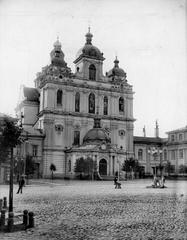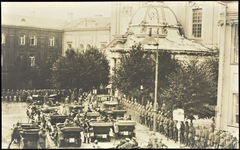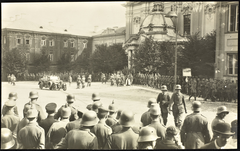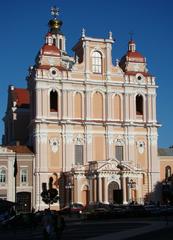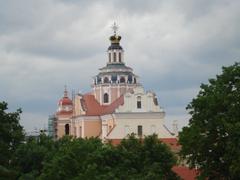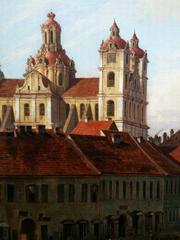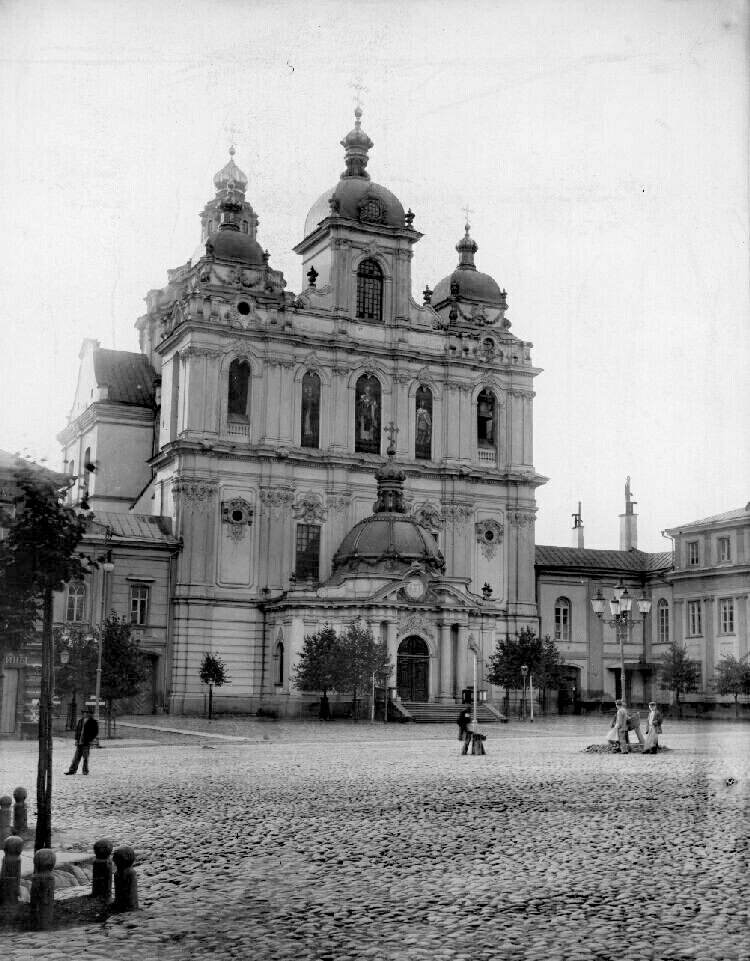
Church of St. Casimir, Vilnius: Visiting Hours, Tickets, and Historical Significance
Date: 14/06/2025
Introduction
The Church of St. Casimir in Vilnius stands as a testament to Lithuania’s enduring faith, resilience, and Baroque artistry. As the oldest Baroque church in the city, it not only dominates the Vilnius skyline with its iconic crowned dome but also symbolizes centuries of spiritual and cultural evolution. Visitors to this remarkable site can immerse themselves in a rich legacy of architecture, religious devotion, and national identity, all housed within Vilnius’ UNESCO-listed Old Town (Vilnius Tourism; Wikipedia).
This guide provides a comprehensive overview of the Church of St. Casimir, including its fascinating history, key architectural and artistic features, practical visitor information, and tips for exploring Vilnius historical sites.
Table of Contents
- Historical Overview
- Visitor Information
- Architectural and Artistic Highlights
- Religious and Cultural Significance
- Special Events and Nearby Attractions
- Guided Tours and Photographic Spots
- Frequently Asked Questions (FAQ)
- Conclusion
- References
Historical Overview
Origins and Foundation
Founded in 1604 in the heart of Vilnius, the Church of St. Casimir was built shortly after the canonization of Lithuania’s patron saint, St. Casimir, reflecting the Catholic resurgence during the Counter-Reformation (Vilnius Tourism). The Jesuit order spearheaded its construction, with strong support from Lithuanian nobility and King Sigismund III Vasa. The church’s location in Old Town underscored Catholicism’s central role in the city’s civic life, and its consecration in 1635 marked it as a spiritual and architectural landmark (Encyclopaedia Britannica).
Architectural Evolution
Early Baroque Design
The church was inspired by Rome’s Church of the Gesù, the mother church of the Jesuits, but adapted to local traditions with twin towers and a three-tiered façade. Architect Jan Frankiewicz, a pupil of Giovanni Maria Bernardoni, introduced these features, which would influence Baroque church design throughout Lithuania (Wikipedia; GoVilnius; cepelinas.eu).
Later Modifications and Restorations
The church has weathered fires, occupations, and repurposing. A 1749 fire led to significant restoration, including the addition of the distinctive gilded crown atop the dome—a symbol of St. Casimir’s royal heritage (TravelGuideEurope.eu; lndm.lt). In the 19th century, it was converted to Russian Orthodox use, with architectural alterations that were later reversed. Under Soviet rule, it became a Museum of Atheism before being restored to Catholic worship after Lithuania regained independence in 1991 (Wikipedia; Baltic Times).
Visitor Information
Visiting Hours and Tickets
- Opening Hours:
- Monday to Saturday: 9:00 AM – 6:00 PM
- Sunday: 12:00 PM – 6:00 PM
(Hours may vary during religious holidays or special events; always check ahead for current times.)
- Admission: Free entry for all visitors. Donations are encouraged to support preservation. Guided tours or special events may require tickets, which can be purchased on-site or through local tour operators (Trip.com).
Accessibility
The church is accessible to visitors with mobility challenges, with ramps at the main entrance and staff assistance available. Some historic areas, such as the crypt, may have limited access.
Travel Tips
- Located centrally in Vilnius Old Town, the church is within walking distance of major attractions.
- Accessible via public transport (nearest stops: Cathedral Square, Town Hall Square).
- Modest attire is recommended.
- Photography is permitted except during services and in designated sacred spaces.
- Early morning or late afternoon visits are ideal for a peaceful experience.
Architectural and Artistic Highlights
- Façade: Three-tiered Baroque design, pastel colors, twin towers—a local adaptation of Il Gesù (Walkable Vilnius).
- Dome and Crown: The 40-meter-high dome, capped with a distinctive gilded crown, dominates the city’s skyline (cepelinas.eu; lndm.lt).
- Interior: Latin cross plan, three ornate Baroque altars, intricate stucco, gilded woodwork, and artificial marble finishes.
- Artistic Works: Altarpieces and paintings by Antanas Kmieliauskas and other notable artists, as well as the revered icon of St. Casimir with three hands (GoVilnius).
- Crypt: 17th-century crypt discovered beneath the altar, containing unique wall drawings and considered a significant burial site (Walkable Vilnius; saintlyways.com).
Religious and Cultural Significance
- The church is a focal point for St. Casimir’s Day celebrations (March 4th), featuring special masses and processions (Lithuanian Tours).
- The annual Kaziukas Fair, rooted in religious tradition, transforms the surrounding Old Town into a vibrant festival of crafts, food, and music.
- The church’s iconography and architecture reflect the Counter-Reformation’s emphasis on awe and Catholic identity (Academia.edu).
- Regular Masses and special services underscore the church’s ongoing role as an active center of worship.
Special Events and Nearby Attractions
- Concerts: The church’s renowned acoustics make it a favored venue for organ and choral performances (Evendo).
- Nearby Sites: Vilnius Cathedral, Presidential Palace, Gediminas Tower, Vilnius University, and the House of the Black Heads are all within walking distance (Earth Attractions; Trip.com).
Guided Tours and Photographic Spots
- Guided Tours: Available through local operators and the Vilnius tourism office, offering insights into architecture, history, and art. Book in advance for access to restricted areas like the crypt.
- Photographic Spots: The church’s façade, dome, and crown are best photographed during golden hour. The interior’s ornate altar and frescoes are also highlights for photography enthusiasts.
Frequently Asked Questions (FAQ)
Q: What are the Church of St. Casimir visiting hours?
A: Typically, 9:00 AM to 6:00 PM daily (Sunday from 12:00 PM). Check for variations during holidays.
Q: Is there an entrance fee or ticket required?
A: Entry is free. Guided tours or special events may require tickets.
Q: Is the church accessible for visitors with disabilities?
A: Main areas are accessible; some historic sections like the crypt may have limited access.
Q: Can I attend Mass or concerts at the church?
A: Yes, regular Masses and organ concerts are open to visitors. Event schedules are posted locally and online.
Q: Is photography allowed?
A: Yes, except during services or in restricted areas.
Conclusion
The Church of St. Casimir is a cornerstone of Vilnius historical sites, embodying Lithuania’s spiritual endurance, cultural richness, and architectural grandeur. From its Baroque splendor to its role in national celebrations and community life, the church invites visitors to experience a living heritage. Plan your visit by checking current hours, consider a guided tour for deeper insight, and enjoy the vibrant atmosphere of Vilnius’ Old Town.
For more tailored travel tips and event updates, download the Audiala app and explore our curated guides to Vilnius and Lithuanian culture.
References
- Vilnius Tourism, Church of St. Casimir
- Encyclopaedia Britannica, Vilnius
- Wikipedia, Church of St. Casimir, Vilnius
- TravelGuideEurope.eu, St. Casimir’s Church and the Jesuit Monastery
- Lietuvos Nacionalinė Martyno Mažvydo Biblioteka
- Vilnius University
- Lithuanian Tours, St. Casimir Fair Tour in Vilnius
- Baltic Times, Articles on St. Casimir
- Trip.com, Catholic Church of St. Casimir
- GoVilnius, Church of St. Casimir
- cepelinas.eu, Church of St. Casimir
- Walkable Vilnius, St. Casimir Church
- SaintlyWays, Church of St. Casimir
- Earth Attractions, Vilnius Itinerary
- SpottingHistory, St. Casimir’s Church
- Evendo, Church of St. Casimir Events
- Academia.edu, The Chapel of St. Casimir in Vilnius: A Counter-Reformation Landmark
- Live the World, Church of St. Casimir
- lndm.lt, Didžioji Street
